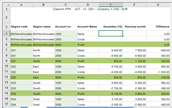The same result as in the Static Row Generation example template (EX_RT103) may be achieved by a combination of dynamic and static row generation. In the Dynamic & Static Row Generation example (EX_RT104) the regions are generated dynamically (values derived from organization, dimension or account structure) and accounts are generated statically (values entered to the workbook).
In Dynamic & Static Row Generation the account blocks (accounts 1000, 2000 and 9000) are automatically created for all regions under the TOP folder in the region structure (dim01).
Figure 39: Automatically generated account blocks
The columns for region code and name are kept in the workbook, but the rows added in the Static Row Generation example (EX_RT103) and the dim01 codes are removed. Name definitions are changed correspondingly.
The following figure depicts the workbook of the Dynamic & Static Row Generation example (EX_RT104).
Figure 40: Workbook of Dynamic & Static Row Generation
Figure 41: Dynamic & Static Row Generation name definitions
In the XML file the following changes are made:
•reportsheet: the value is changed to dynamic so it is in line with the dynamic row generation
•generatetype: the value input means that all units under the folder indicated with the udid element are generated to the report
•udid: the value is set to the folder (TOP), whose child units are needed to be shown on the report
•static: the value false means that this dimension is generated dynamically
Figure 42: Changed definitions
When opening the Dynamic & Static Row Generation example (EX_RT104) we get a slightly different report than with Static Row Generation (EX_RT104) . There is one more block, namely the BWNonAllocatedItem region. There would be figures in the BWNonAllocatedItem region if data had been entered for Company X on an input sheet where the region was not specified.
Figure 43: BWNonAllocatedItem block
Now as this 'region' has no entries we might not want to show it on the report. This is achieved by adding the removeemptyblocks element (with the value true), which defines whether all account, unit, and dimension combinations are shown in the generated template, or only those for which data exists.
Figure 44: removeemptyblocks





